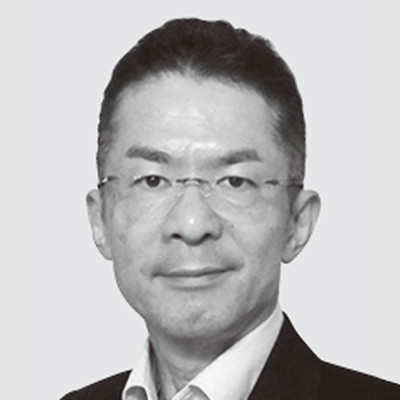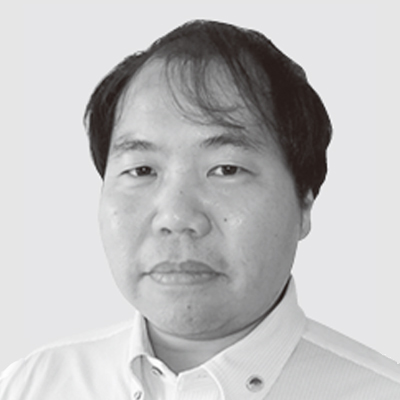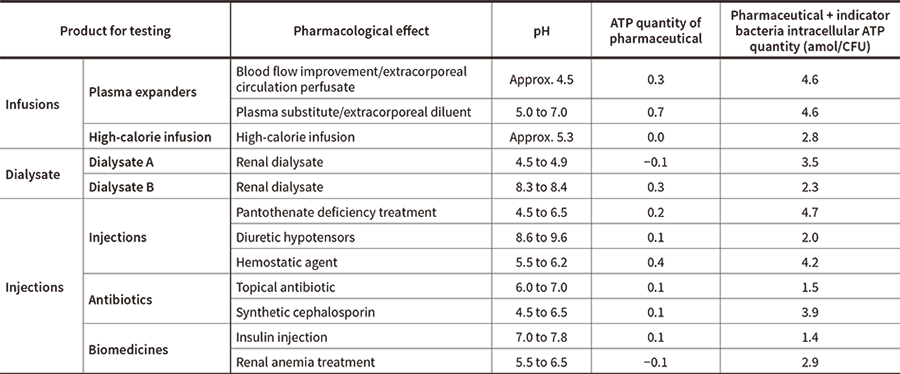World-leading Measuring Instruments and Systems
Rapid microbial testing system Lumione detects the presence of microorganism by measuring adenosine triphosphate at the extremely low quantity of 10–18 mol. Unlike the agar culture method currently in widespread use, it enables measurement without culturing and provides rapid results in as little as 1 hour. Water used in the manufacturing process for pharmaceutical products is required to undergo testing for microorganism. While this testing takes 7 days with the conventional culture method, a Lumione system can reduce this time to around 1 hour. This rapid microbial method enables faster startup time for pharmaceutical water facilities and improves the availability factor of medical product production facilities. When problems occur, it also minimizes the scope of impact and enables rapid identification of causes. It should also help improve the risk management and quality of pharmaceutical product manufacturing.





The culture method is in widespread use as a microbial test used in pharmaceutical product manufacturing, but test results can take anywhere from a few days to more than 10 days to obtain. This delay results in many pharmaceutical manufacturers having to store pharmaceuticals for 2 to 4 weeks before shipment, creating business challenges in terms of storage costs and cash flow. It also creates major challenges for quality control, such as the difficulty of identifying the bacterial contamination route when a problem occurs since manufacturing equipment and other cleaning has already finished by the time test results are available. Various rapid microbial methods (RMM) have been proposed as ways of solving these issues. Examples include direct methods such as solid-phase or flow cytometry, and indirect methods such as the immunological method, nucleic acid amplification method, bioluminescence method, fluorescence method, impedance method, gas measurement method, and weight analysis method. The rapid method currently being embraced by the market is the microcolony method, which combines short-term culturing and high-sensitivity detection (such as the bioluminescence method and fluorescence method). Since it is based on the culture method, this method is closely related to conventional plate or liquid culture methods, giving it the benefit of making it easy to perform the validation needed when adopting new test methods. The culture method can currently reduce test times by several days, with tests previously requiring 7 days sometimes done in just 3 days. But even faster testing is needed. Methods such as the bioluminescence method, cytometry method, and nucleic acid amplification method enable RMM in a matter of hours, but have had difficulty enabling microbial control at the same level as the culture method since their sensitivity levels are usually on the order of 10 to 100 colony-forming units (CFUs, a unit representing the formation of one colony in an agar culture; corresponding to one microorganism).
Rapid microbial testing system Lumione BL-2000 (Lumione), developed by Hitachi High-Tech Solutions Corporation (see Figure 1), uses the adenosine triphosphate (ATP) bioluminescence method to measure the ATP in microorganism without culturing. It manages to combine RMM enabling results in a matter of hours, with high sensitivity on the order of 1 CFU. This article introduces Lumione in detail.
Figure 1—Lumione BL-2000 System Shown here is the rapid microbial testing system Lumione BL-2000 released in June 2018.
Shown here is the rapid microbial testing system Lumione BL-2000 released in June 2018.
The ATP bioluminescence method uses the luminescence produced by the luciferin-luciferase reaction to detect the ATP present in the cells of all organisms. Discovered about a century ago, the luciferin-luciferase reaction has a long history.
Using this reaction as its operating principle gives the ATP method the benefit of not generating false-positive results from nonmicrobial microparticles, which is a problem with other methods such as the fluorescence test method. But the ATP method requires extra steps for breaking down and removing ATP to deal with ATP contamination from test workers and ATP in samples containing matter from organisms.
The quantity of ATP in microorganism is extremely small (10–18 mol = 1 amol (attomol)), and can vary widely for different microorganism species and cell condition. Amol is the SI symbol for amol, a unit of measurement so minute that 1 amol is equivalent to the change in salinity produced by adding about one-third of a teaspoon of salt to the 27.5-trillion-liter volume of Lake Biwa. The actual quantities of ATP contained in microorganism are known to range from a few hundred amol per CFU for microorganism with large cells such as yeast, to around 1 amol for gram-negative bacteria with low intracellular volumes(1). So, for microbial control at the same 1-CFU level as the culture method, an ATP quantity detection sensitivity of 1 amol is considered necessary. But since the detection sensitivity of the conventional ATP method is about 102 to 103 CFU (or about 102 to 103 amol by ATP quantity)(2), it has had difficulty with microbial control on the order of 1 CFU. Hitachi has responded by looking for a way to increase sensitivity through the development of the technology described below.
The ATP luminescence produced by the luciferin-luciferase reaction peaks immediately after the sample containing the ATP has reacted with the luminescence reagent, and diminishes rapidly thereafter. The Lumione system developed by Hitachi has a mechanism that automatically dispenses the luminescence reagent, and can measure luminescence in real time. These features enable the maximum luminescence quantity found immediately after the start of the reaction to be detected with good reproducibility. Steps have also been taken to improve the optical system layout to enable waste-free luminescence detection, and to improve the signal-to-noise (S/N) ratio through the use of signal processing technology. A joint development project with a reagent manufacturer has resulted in the development of special reagents optimized to minute amol-level quantities, and background ATP has been reduced by creating special manufacturing processes for the equipment used with the system. These processes prevent ATP contamination during manufacturing.
Figure 2 shows an example calibration curve for an ATP concentration range of 0 to 10 amol. The slope value obtained from the calibration curve was calculated using the formula given in the Japanese Pharmacopoeia (a standard reference work for pharmaceuticals)(3), and the limit of detection was found to be 0.3 amol. So Lumione has demonstrated a detection sensitivity of less than the 1 amol needed for microbial control on the order of 1 CFU.
As shown in Figure 1, Lumione is composed of a measurement unit, control unit, and control PC. The measurement unit measures the sample, and can be installed in a bio-safety cabinet or clean booth, creating a structure that is independent from the control components.
Computerized system validation (CSV) is the process used to verify that computers used in pharmaceutical product manufacturing operate normally in accordance with their stated purpose. CSV is mandated by regulations around the world such as the guidelines of the Ministry of Health, Labour and Welfare in Japan; by Title 21, Part 11 of the Code of Federal Regulations (CFR) set forth by the Food and Drug Administration (FDA) in the USA; and by Annex 11 of EudraLex in the EU. Lumione's software has a number of functions for CSV compliance. It authorizes each user, manages the login history, and has audit trail search, store, and output functions. It also has functions to prevent data falsification, and to back up and restore data.
Figure 2—Calibration Curve and Detection Limit Shown here is the calibration curve for measurement of five samples of 0, 1, 2, 5, and 10 amol.
Shown here is the calibration curve for measurement of five samples of 0, 1, 2, 5, and 10 amol.
Pharmaceutical product manufacturers must follow the rules given in the Japanese Pharmacopoeia as specified by the Pharmaceutical Affairs Law. They include rules regarding the water used in pharmaceutical product manufacturing (pharmaceutical water) that require the presence of microorganism to be controlled within the prescribed standards. Specifically, microorganism must be controlled to within a level of less than 100 CFU per milliliter for the common water serving as the source water in pharmaceutical water manufacturing; less than 100 CFU per milliliter for the purified water used in processes such as tablet manufacturing and production equipment cleaning; and less than 10 CFU per 100 milliliters for water for injection used in processes such as injection preparation manufacturing. As the most standard method of microbial control for pharmaceutical water, the Japanese Pharmacopoeia specifies a method that involves filtering the pharmaceutical water with a flat filter, then culturing it for 4 to 7 days on one or two types of agar culture media (the filter membrane method). Many pharmaceutical manufacturers have to wait seven or more days after manufacturing pharmaceutical products to finalize the microbial testing results.
In response to this problem, a new section entitled “Rapid Microbial Methods” was added to the 17th Edition of the Japanese Pharmacopoeia released in March 2016. Added to promote the widespread use of rapid methods, it specifies the rapid methods that can be used for microbial control during medical product manufacture, along with the basic approach used for the validation required when adopting rapid methods. The ATP method has also been included as a rapid method, making it compliant with the Japanese Pharmacopoeia and creating an environment enabling its worry-free adoption by pharmaceutical manufacturers. Figure 3 shows the test procedure for testing pharmaceutical water. A sample extracted by the same procedure used with the conventional culture method is aspirated using Lumione's filter assembly. This filter assembly has a 100 ml funnel mounted on it during use, enabling filtration of 100 ml of pharmaceutical water in no more than 10 minutes. Living cells, dead cells, and contaminating ATP are captured by the filter after filtration. Since the aim of microbial testing is to detect living microorganism, the dead cell ATP and contaminating ATP need to be broken down and removed. In environments hostile to their growth, populations of microorganism include types that have entered a dormant state and resemble seeds. These microorganism are known as spores, and ATP is difficult to extract from them. The activation/elimination reagent included in Lumione's reagent kit is used as a way to solve this problem. Its aim is to activate the spores to transform them into a state enabling ATP extraction. The solution is added to the filter, which is then incubated by a block heater for 40 minutes at 37°C. This step enables ATP elimination and activation at the same time. The filter is then rinsed with cleaning solution, then the remaining solution is removed by centrifugal filtration. The filter is then placed in Lumione's measurement tube and extraction reagent is added to the filter. It is left to settle for 5 minutes at room temperature before the extraction reagent is collected in the measurement tube by centrifugal filtration. The measurement tube is placed in the measurement tube rack, the rack is mounted in Lumione, and luminescence measurement is performed for 5 minutes per sample.
The processes described here can extract the microorganism in 100 ml of pharmaceutical water in as little as 1 hour. Figure 4 shows examples of measured intracellular ATP quantities per CFU for microorganism detected in intravenous water using these processes. In all, nine microbial species were targeted for detection. These species are specified in the General Information of the Japanese Pharmacopoeia in connection with quality control for pharmaceutical water and performance testing of culture media used in sterility testing for pharmaceuticals. The same sample was measured by the culture method and ATP method, and the intracellular ATP quantity was calculated by dividing the ATP quantity obtained by the ATP method by the number of colonies obtained by the culture method.
The intracellular ATP quantity was about 1 amol/CFU for the least common species (the gram-negative bacillus Methylobacterium extorquens), and about 100 amol/CFU for the most common (the yeast Candida albicans). The values for other microorganism were the same as the intracellular ATP quantity values given in the reference(1). These findings demonstrate that a detection sensitivity of 1 amol enables detection on the order of 1 CFU.
Figure 3—Test Processes These illustrations and photos show the actual operations done during pharmaceutical water testing processes.
These illustrations and photos show the actual operations done during pharmaceutical water testing processes.
Figure 4—Intracellular ATP Quantities of Microbial Species in Japanese Pharmacopoeia Shown here are the results of Lumione measurements of per-cell intracellular ATP quantities for the microorganism specified by the Japanese Pharmacopoeia for use in performance testing of culture media used in pharmaceutical water quality control and sterility testing.
Shown here are the results of Lumione measurements of per-cell intracellular ATP quantities for the microorganism specified by the Japanese Pharmacopoeia for use in performance testing of culture media used in pharmaceutical water quality control and sterility testing.
Table 1—Repeatability (Compliance Test During Operation) Shown here are example repeatability results obtained for an compliance test during operation at an actual client site.
Shown here are example repeatability results obtained for an compliance test during operation at an actual client site.
The adoption of a rapid method for actual microbial testing of pharmaceutical water requires validation that conforms with the “Validation of Analytical Procedures”(3) provision for pharmaceutical product analysis/testing in the 15th Edition of the Japanese Pharmacopoeia. The items that require conformance are accuracy, precision, specificity, detection limits, quantification limits, linearity, range, and robustness. At the time of the 15th Edition, rapid methods were deemed impossible to perform since no measurement method existed that had the attomole-level accuracy required by the ATP method.
For precision testing, Hitachi used the extraction reagent included in Lumione's reagent kit (also used as the negative control, NC), and a positive control (PC) with an ATP concentration of 100 amol/50 μL. Table 1 shows example repeatability results obtained for an actual compliance Test during operation. The results exhibited good reproducibility and met the evaluation criteria with a range of –0.1 to 0.1 amol for the NC samples and a coefficient of variation (CV) of 3% for the PC samples. Figure 5 shows example results obtained for linearity. Samples with ATP quantities ranging from 0 to 5,000 amol were tested. The results indicated good linearity, with a correlation coefficient of 0.9998. The repeatability for the high-concentration 5,000 amol sample had the same CV (about 3%) as the low-concentration 100 amol sample, so no concentration-specific difference was found. These findings verify that Lumione's performance makes it suitable for use in analysis methods used in pharmaceutical product manufacturing.
Figure 6 shows an example comparison of the ATP method and culture method using samples of pharmaceutical water actually used by a pharmaceutical manufacturer. Six samples of common water and refined water were taken from the same sampling point, and measurements were made using the culture method and ATP method for each of three samples. In the common water samples, the culture method detected microorganism at a level of about 70 CFUs, and the ATP method detected ATP quantities of about 500 to 1,000 amol. The large variation among the ATP method results may have been due to differences in microorganism species in different samples. The same measurements were made for the refined water samples. The culture method detected no colonies, and the ATP method detected ATP quantities of –0.1 to 0.1 amol (below the detection limit). So the culture method and ATP method yielded the same result, demonstrating that Lumione can be used for microbial control in pharmaceutical water.
The ATP luminescence method is a test that destroys microbial cells, preventing microbial identification testing on the same sample afterward. To address this challenge, a sample quantity large enough to enable retesting by the conventional culture method is used, or a second sample is taken and tested by the conventional culture method. This approach is used to check the reproducibility of bacterial contamination and to carry out microbial identification testing by conventional methods if reproduced. Since microbial testing with Lumione only requires about 1 hour, the time lag is no more than a few hours, which should pose no problems for operation.
Lumione's main benefit is the RMM it provides that enables results in just hours. To take advantage of this benefit, manufacturers may use Lumione for microbial control before final sterilization and control of other intermediate processes during pharmaceutical product manufacturing. Table 2 shows the results of measurements on pharmaceuticals. The test processes conform to the pharmaceutical water test flow shown in Figure 3. A cleaning process using phosphate buffered saline (PBS) was added after sample filtration to eliminate the effects of sample-derived components. When samples such as dialysate, freeze-dried pharmaceuticals, infusions, and ampoule preparations were measured, the sample-derived ATP quantities were found to be less than 1 amol, and the background ATP contained in samples was in a negligible range. Even in infusions containing components prone to ATP contamination, such as amino acids and glucose, the background ATP could be kept to within a negligible range. Among biomedical products, there were no effects found from culture cell-derived ATP when the products were in a refined state such as before final sterilization.
Spores of Bacillus subtilis were added as an indicator bacterium to determine whether testing was possible without interference from sample-derived components. Even for samples with a clearly acid or alkaline pH, such as dialysate, no interference was found and the ATP quantity in the sample was similar to the 2 amol/CFU figure measured in pharmaceutical water (see Figure 4). The test also found no interference for antibiotics designed to inhibit microbial growth, which also contained ATP quantities similar to the quantities in pharmaceutical water.
So as described here, Hitachi investigated various components related to pharmaceuticals enabling filtration and obtained findings suggesting that microbial control on the order of 1 CFU is possible just as with the culture method. But when adopting this ATP method for actual pharmaceuticals, manufacturers will need to validate its use for each one separately.
Table 2—Microbial Testing of Pharmaceutical Products (Infusions, Dialysis Solutions, Injections) Shown here are the results of tests done to determine whether the presence of microorganism could be detected, carried out on actual pharmaceutical product samples.
Shown here are the results of tests done to determine whether the presence of microorganism could be detected, carried out on actual pharmaceutical product samples.
This section describes an example showing how the ATP method can be applied to antibacterial tests and disinfection tests. These tests consist of adding a known microorganism to a test sample and evaluating the effectiveness in terms of microbial growth inhibition or microbial reduction. Since the microbial concentration used in these tests is high, the high detection sensitivity used previously is not necessarily required. Therefore, the solution mixing method was used, which has the simple pretreatment illustrated in Figure 7. The method consisted of adding the cleaning solution included in Lumione's reagent kit to the sample solution, incubating it for 30 minutes to remove the extracellular ATP, adding extraction reagent to extract the intracellular ATP, and then using Lumione to perform luminescence measurement.
Figure 8 shows example results of disinfection tests using a client-supplied disinfectant. The disinfectant was adjusted to concentrations of 0, 0.1, 1, and 10 ppm, Candida albicans was added in a concentration of 7.8 × 104 CFU/ml, and then the tests were performed after 4 hours had elapsed. The culture method consisted of preparing a dilution series, culturing the samples on agar culture media, and then measuring the living microbial quantities. The ATP method consisted of using the solution mixing method to measure the ATP quantities, and then using each result to calculate the logarithmic reduction factor indicating the order-of-magnitude reduction in added microbial quantity after 4 hours.
As shown by the graphs in Figure 8, the ATP method showed the same tendency of decreasing logarithmic reduction factor in proportion to decreasing disinfectant concentration as the culture method. The results show a difference in logarithmic reduction factors between the two methods. The inferred cause of this difference is that the culture method detects only living cells that are capable of propagation, while the ATP method detects all living cells regardless of propagation ability.
The advantages of using the ATP method for antibacterial property tests and disinfection tests are rapidity (same-day results) and the simple sample processing procedure. The culture method requires a complicated sample processing procedure. To adjust the microbial quantity in each petri dish, a dilution series is prepared from a single sample, cultures are grown in multiple petri dishes for the multiple concentrations in the series, and then the colonies in each culture are counted. In contrast, the ATP method's linearity of about 3 or 4 orders of magnitude eliminates the need for a dilution series, enabling sample preparation with a single microtube.
Hitachi has been able to demonstrate that Lumione is a rapid microbial testing system that can combine rapidity (results in hours) with high sensitivity on the order of 1 CFU. The company plans to work on promoting the widespread adoption of the ATP method by the pharmaceutical industry and to develop applications eliminating sample-derived ATP effects through improvements in pretreatment methods. These applications will target the food/beverage and regenerative medicine industries where demand is high, and these efforts will help create benefits such as shorter test times and better quality.
The authors would like to express their heartfelt appreciation to the members of CMC Development Laboratories, Shionogi & Co., Ltd. who provided pharmaceutical water samples and input and advice on validation, along with the members of Hitachi General Hospital who assisted with the purchasing of pharmaceuticals.